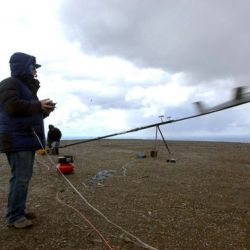 The demand for unmanned aircraft systems (UAS) is rising, both nationally and internationally. Unmanned aircraft can, for instance, be used to monitor dikes, inspect borders and conduct surveillance operations for the police and military. For civilian use, UASs especially offer technical, economic and environmental advantages. During military or paramilitary missions, a UAS is a cost-effective solution for operations that are deemed as too mundane or indeed dangerous for manned flights. Now, for the first time, the National Aerospace Laboratory (NLR) is conducting fundamental research to determine the skills and competencies required for operating a UAS.
The demand for unmanned aircraft systems (UAS) is rising, both nationally and internationally. Unmanned aircraft can, for instance, be used to monitor dikes, inspect borders and conduct surveillance operations for the police and military. For civilian use, UASs especially offer technical, economic and environmental advantages. During military or paramilitary missions, a UAS is a cost-effective solution for operations that are deemed as too mundane or indeed dangerous for manned flights. Now, for the first time, the National Aerospace Laboratory (NLR) is conducting fundamental research to determine the skills and competencies required for operating a UAS.
To date, operational training research for UASs has not been conducted (inter)nationally, as this requires the measurement of learning curves, which is both a time-consuming and expensive procedure. Nevertheless, the use of UASs is growing fast, and thus so too is the demand for capable UAS operators. In fact, at present, the United States Air Force (USAF) is training more UAS operators than fighter pilots.
The NLR research involved mapping all the actions and activities performed or needed by UAS operators during the course of their work. Next, in order to establish a competencies profile, the researchers set out to determine the exact characteristics required of a UAS operator. The subsequent research revealed that UAS operators (1) must have good communication skills, (2) must be able to properly divide their attention, (3) must have good memories or short-term memories, (4) must be able to reason logically, (5) must not be easily distracted, and (6) must be able to properly manage visual searches, meaning that an operator should be able to actively scan the visual environment for a specific object (the objective) among various other objects (distractions).
Upon completion of an IQ test, a communication test, and a Useful Field Of View (UFOV) test, the test subjects participated in missions in the simulator. The IQ test measures memory and logical reasoning powers. The UFOV test, which was originally designed to test the driving skills of senior citizens, measures how adept people are at dividing their attention and visually searching for objects.
At the end of each mission, the test subjects were apprised of their results or scores, so that they could then learn from their mistakes. In this way it is possible to measure the learning curve of each participating test subject. A number of the hypothesized competencies, such as logical reasoning and memory, indeed seemed to be predictive of an operator’s overall performance level, although certain gradations were revealed during this process. Test subjects who, for example, had relatively low scores for logical reasoning but high scores for memory (type 1) performed better at the start of the missions, but improved little thereafter, while, to the contrary, those test subjects who had relatively high scores for logical reasoning and low scores for memory (type 2) displayed steeper learning curves, despite their relatively low scores at the start of the mission.
What does this ultimately mean for the world of UASs? For one, it means that UAS operators can be selected, and also seemingly trained, based on competencies. Complex missions demand extremely capable operators, for which a steep learning curve during training is required. Selecting and training operators based on the relevant competencies can therefore be of (great) importance in this process.

